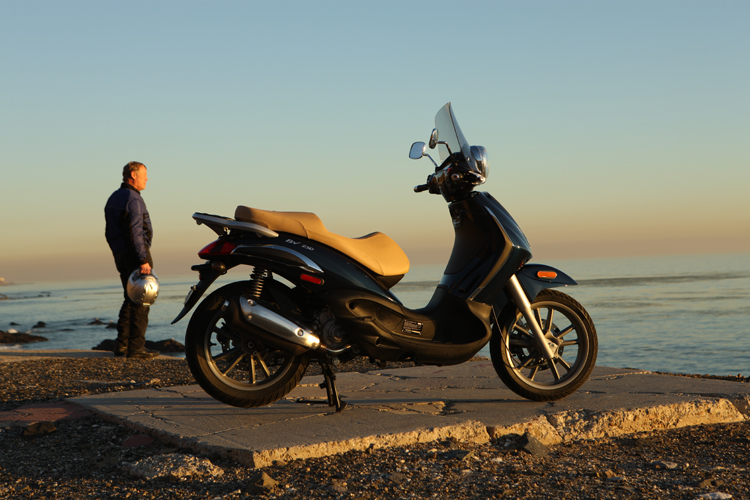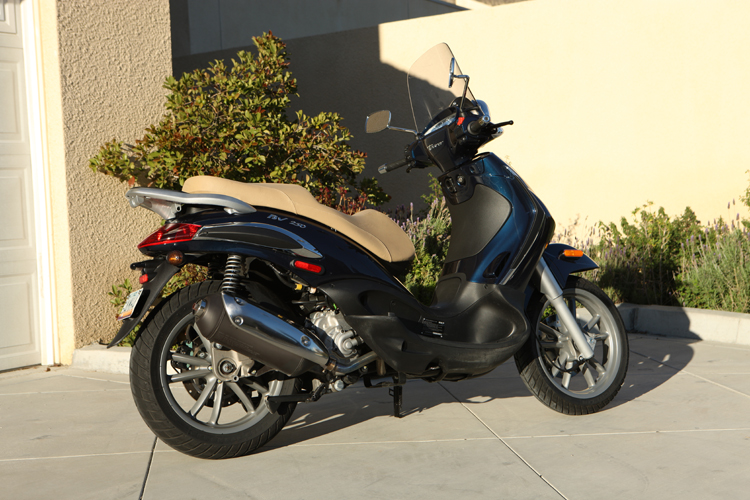2009 Piaggio BV Tourer 250

Smack dab in the middle of the scooter-displacement range, Piaggio's BV Tourer 250 blends the traits of the smaller, lightweight machines so popular in Europe and Asia with the bigger road-burners found in the US. First introduced in 2006, the BV250 is virtually unchanged for 2009 - a solid indication that it has been a good model.
Scooter sales in the United States have been booming of late, and as one of the world's largest manufacturers of scooters, Piaggio is well positioned to satisfy increased demand. Their corporate tent (holding the Vespa, Gilera and Derbi scooter brands, and Aprilia and Moto Guzzi motorcycles) certainly brings considerable research and development resources to the party, allowing the company to produce efficient, stylish and quality machines.
The BV250 gets its motivation from a spunky 244cc SOHC single-cylinder "motore" with a four-valve combustion chamber. The electronically fuel-injected engine is rated 22 horsepower at 8,250 rpm and 14.9 ft-lbs of torque at 6,500 rpm. Piaggio refers to it as a QUASAR, for "QUArter-liter Smooth Augmented Range" - whatever that means. We do know that it is a quarter liter and it's quite smooth, but we'll have to get back with you on the "Augmented Range" part.
A continuously variable transmission (CVT) with automatic centrifugal clutch makes shifting a thing of the past, and a geared final drive carries the power to the rear wheel. This drivetrain is shared with Piaggio's unique three-wheeled MP3 250 scooter, but the BV250 is 122 pounds lighter, which translates into better acceleration and all-around performance.

The EFI has no manual cold-start controls and no neutral. The starting drill requires retraction of the sidestand, a squeeze of the brake lever, and pressure on the starter button. This model, unlike the MP3 500, has no parking brake either - so when the engine is off, the transmission permits the scooter to roll freely, and that means extra care must be taken about where it's parked or you may be running downhill after it yelling, "Oh no, Mister Bill!"
The engine springs to life almost instantly and is ready to go right away, with excellent drivability. We found that the BV250 will scoot away from in-town traffic with smooth, seamless acceleration from idle to redline. In acceleration from a stop, the engine purrs like a small outboard motor, picking up speed in a linear fashion free of gear changes. However, growing accustomed to the engine staying at one speed while the scooter seems to catch up to it, rather than going up through the gears, takes a while.
On the highway, the BV250 pulls sprightly off the line and, when ridden solo, adequately maintains speed on long highway grades. However, when pulling out to pass above about 50 mph, there's not much acceleration or passing power left (especially so with a passenger on board); and if you're on an upgrade too, well, you'll just have to be patient.
Piaggio states a top speed of 77 mph in its specifications, which appears to be accurate. The optimistic speedometer indicates a top speed of about 87 mph on flat roads, with the rev limiter cutting in at an indicated 92 mph on a slight downhill. However, when our GPS showed 77 mph the speedometer read 86 mph.
Premium fuel is recommended, and average mileage during testing was 59.5 mpg, with a low of 52.9 and high of 65, which certainly qualifies as fuel thrifty. The BV250's range is constrained by limited fuel capacity, only 2.6 gallons total, and we'd like to see its range 'augmented' with a larger tank fitted, perhaps 3.5 or 4.0 gallons. Typically, the low-fuel lamp begins to flicker around 112 to 130 miles, at which time the BV250 needs just over two gallons of gas.

Brakes & Tires
A 260mm front rotor with a two-piston floating caliper and a twin opposed-piston caliper with the 260mm rear platter provides stopping power. Both sets of calipers use stainless steel brake lines, adding a touch of class to the components.
The discs deliver ample braking at both ends, but the front brake is noticeably more aggressive than the rear. No signs of brake fade were noted, even after repeated stops, and the brakes remained quiet and required little lever effort. However, if you're used to riding motorcycles with a clutch on the left, be careful about reflexively pulling the left lever in hard as you roll to a stop.
The absence of transmission gears means less engine-braking on downhill sections and when decelerating from high speeds, and that forces the rider to rely solely on the brakes. Nice updates would be an engine-braking control on the transmission and a locking Park position.
Wheel sizes are large for scooters, with a tubeless 110/70-16 in front and a 140/70-16 rear. Their grip is good too, allowing steep leaning into corners, although they do give up a bit early under hard braking. Rain traction is also good, and though not bad in concrete rain grooves, the tires we tested chased longitudinal pavement joints.
Suspension & Handling
A conventional (to motorcycles) nonadjustable damper-rod hydraulic fork with 35mm shafts and 4.1 inches travel is used up front, rather than the trailing-link fork often found on scooters. Out back, twin hydraulic shock absorbers with four-position spring preload deliver 3.5 inches of travel.
Handling is quick, light and nimble, making it easy to make tight U-turns, zip in and out of traffic, and negotiate the urban landscape. Under most circumstances and moderate speeds, stability is fine. However, if you lean it hard into a high-speed corner that has some pavement imperfections, things get squirrelly in a hurry.
Ride quality is typical of most scooters. Its basic suspension with short travel and high un-sprung weight (due to the rear-suspension engine mounting) delivers a choppy ride on rough pavement. Repetitive uneven expansion joints in concrete roadways can upset the BV250's ride, giving both rider and passenger a good thumping

Ergonomics & Accoutrements
A tall front end provides considerable wind protection, but the dash and windscreen feel too close to the rider (10" from my helmet's chin-bar to screen), producing a snug, cramped cockpit environment. The windscreen is also too low for taller riders like me (6'1"); and in order to reduce wind noise along the bottom of my helmet, I had to duck about three inches.
The bi-pod dash cluster contains a round analog 120-mph speedometer with single tripmeter on the left, and paired analog coolant-temperature and fuel-level gauges on the right, along with a digital clock and the usual indicator lamps. The dash looks nice and is easy to read day or night. An electronic anti-theft immobilizer helps prevent ignition-lock breakage and a stolen ride. It has a small LED on the dash that blinks to let anyone know it's there, but there's no audible alarm.
Mirrors are widely spaced and offer a clear, blur-free view. The single headlight provides a modest amount of light on low beam - the high beam is much better - and it's mounted high, too high actually, as the clear top edge glares onto the windscreen at night.
The front portion of the large, double saddle has a height of 30.9 inches, tapered with a slight forward slope and a stepped rear edge which pushes the rider forward. The passenger's portion of the seat feels roomy by comparison and has well-placed footrests and hand grabs for security. The seat is hinged at the front and tilts up for access to the locking, lighted compartment underneath. An electric pushbutton release to the left of the ignition switch makes it easy to open, and there's another cable release inside the front panel just below the key switch, in case the battery goes dead. The electric switch will operate even if the key is removed, unless the steering is locked, so be sure to do that when parking.

Pushing in on the ignition key and lock grants access to the storage bays fronting the rider's knees, which hide the seat and gas-flap releases. Re-latching the flap isn't as simple though. Ours required having one hand on the release lever with the other pushing down on the cover. And this model's under-seat storage space is scant compared to scooters that can hold one or two full-face helmets. There's enough room for a light jacket and some gloves, but not much more. We used a tail bag to augment storage capacity. An optional top box and small luggage side cases are available as accessories.
Final Thoughts
The BV250 is best suited for around-town riders who typically don't ride long distances or travel at high speeds for extended periods. With a suggested retail price of $ 4,899, the BV250 isn't cheap, but it's significantly less than the $ 6,899 you'll pay for Vespa's GTV250, which shares the same drivetrain. Those who do like to ride at higher speeds, for longer distances or two-up, will find that the larger-displacement BV500 offers similar design and styling, with considerably more oomph for an extra $ 1,400.
Our BV250 test scooter displayed quality fit and finish, and delivered reliable transportation day in and day out, rain or shine. A nimble and attractive machine, definitely fun to ride, it also has just the right amount of Italian flair to make it stand out from the crowd.
Technical Specs
+ clean, modern styling, good mileage, nimble handling
- limited cargo capacity, costly for a machine that struggles on the freeway
Distributor Piaggio USA, Inc.
MSRP $ 4,899
Engine 4-stroke SOHC single
Displacement 244cc
Bore and Stroke 72x60mm
Fuel System electronic fuel injection Power22hp @8,250rpm
Cooling liquid w/thermostatic electric fan
Ignition digital electronic
Transmission continuously variable with automatic centrifugal clutch
Frame twin-cradle steel chassis
Front Suspension 35mm conventional fork, 4.1in (104mm) travel
Rear Suspension dual shock absorbers, four-position preload, 3.5in (90mm) travel
Rake/Trail n/a
Brakes Front/Rear single 260mm disc, 2-piston caliper/
single 260mm disc, floating caliper with opposed pistons
Front Tires tubeless 110/70 - 16
Rear Tires tubeless 140/70 - 16
Dry Weight 328lbs (149kg)
Wheelbase 57.9in (1,470.6mm)
Seat Height 30.9in (785mm)
Fuel Capacity 2.6gal (10l)
Fuel Consumption 59.5mpg
Colors Cortina Gray, Midnight Blue








